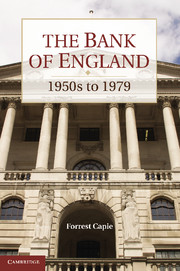Book contents
- Frontmatter
- Contents
- List of Illustrations
- List of Figures
- List of Tables
- Foreword by Mervyn King
- Preface
- Acknowledgements
- Abbreviations and Acronyms
- 1 Introduction and Overview
- 2 The Bank in the 1950s
- 3 The Monetary Setting and the Bank
- 4 The Bank's External Responsibilities to 1964
- 5 From Crisis to ‘Crucifixion’
- 6 Domestic Monetary Policy after Radcliffe
- 7 Other Activities and Performance
- 8 Sterling from Devaluation to Smithsonian
- 9 The Road to Competition and Credit Control
- 10 Competition and Credit Control
- 11 The Secondary Banking Crisis
- 12 Banking Supervision
- 13 Monetary Targets and Monetary Control
- 14 The Bank and Sterling in the 1970s
- 15 The Bank's Freedom to Operate
- 16 Epilogue
- Bibliography
- Index
- Titles in the series
10 - Competition and Credit Control
Published online by Cambridge University Press: 05 July 2011
- Frontmatter
- Contents
- List of Illustrations
- List of Figures
- List of Tables
- Foreword by Mervyn King
- Preface
- Acknowledgements
- Abbreviations and Acronyms
- 1 Introduction and Overview
- 2 The Bank in the 1950s
- 3 The Monetary Setting and the Bank
- 4 The Bank's External Responsibilities to 1964
- 5 From Crisis to ‘Crucifixion’
- 6 Domestic Monetary Policy after Radcliffe
- 7 Other Activities and Performance
- 8 Sterling from Devaluation to Smithsonian
- 9 The Road to Competition and Credit Control
- 10 Competition and Credit Control
- 11 The Secondary Banking Crisis
- 12 Banking Supervision
- 13 Monetary Targets and Monetary Control
- 14 The Bank and Sterling in the 1970s
- 15 The Bank's Freedom to Operate
- 16 Epilogue
- Bibliography
- Index
- Titles in the series
Summary
The 1970s would turn out to be the worst decade of the century in British monetary, financial, and macroeconomic history, as well as that of many other countries in the Organisation for Economic Co-operation and Development (OECD). In Britain, inflation would reach its worst levels ever recorded (wartime or peacetime), serious banking instability would appear for the first time in over a hundred years, there was the largest ever asset price collapse, and the performance of the real economy would be worse than it had been since the late nineteenth century. None of that was obvious as the decade opened, although there were some ominous indicators. The 1967 devaluation had taken longer to work than expected, serious doubts surrounded the effectiveness of lending controls, and inflation was rising. The newly elected Conservative Government of June 1970 seemed set on promoting competition and moving away from the interventionist and planning approach of the 1960s. But there was still the belief that inflation was sensitive to the level of unemployment and that it was essentially a non-monetary phenomenon. In any case, hardly had the new course been set when unemployment started to rise in 1971, and there was an almost immediate reversal of the policies of the 1960s.
At the beginning of the decade, the government believed that they could raise the rate of economic growth, and they set out to do that.
- Type
- Chapter
- Information
- The Bank of England1950s to 1979, pp. 483 - 523Publisher: Cambridge University PressPrint publication year: 2010



